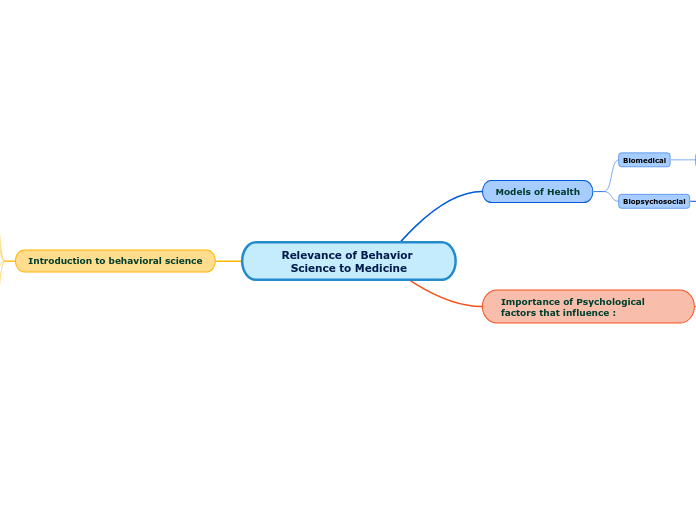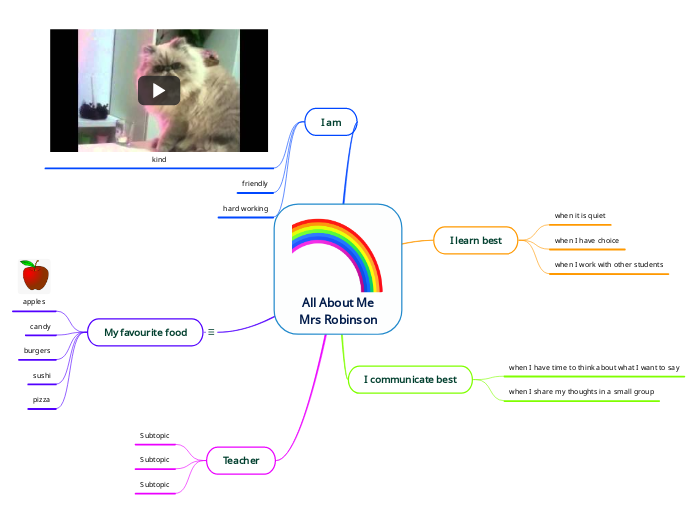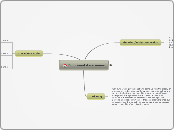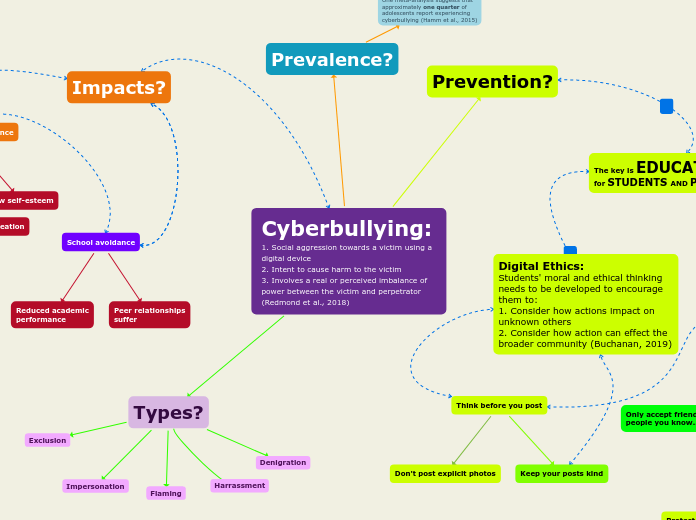Health
3-understanding pain; managing chronic & terminal illness
understanding death
death in old age
more prepared
easier
death in middle age
realistic & fearful
reactions to young adult
shock ,outrage ,acute sense of injustice
children's understanding
9 & above
death is universal
age 5 to 9
death is final
up to age 5
great sleep
pain control techniques
guided imagery
distraction
relaxation techniques
biofeedback
sensory control
surgical control
pharmacological control
kinds of pain
chronic
acute
psychological significance of pain
depression & anxiety worsen the experience of pain
perception of pain
medical consequences of pain
lead individual to seek treatment
pain?
unpleasant sensory & emotional experience associated with actual or potential tissue damage or described in terms of such damage
2-Encouraging health related behaviors
adherence
factors decrease adherence
little disruption of activities
complex treatment
anger at the physician
chronic illness
factors increase adherence
simple treatment schedule
peer support
acute illness
limitation of usual activities
feeling ill
facilitating behavior change
prochaska's model
6-termination
5-maintance
4-action
3-preparation
2-contemplation
1-pre-contemplation
health belief model
strategies
self reinforcement
self control
modeling
self monitoring
self efficacy
factors
person believes that particular health practice will
be effective in reducing threat
personal health threat
changing health habits in adults
message framing
fear appeals
health behavior education appeals
intervening with children & adolescents
teachable moment
impact of early socialization
practicing & changing health behaviors
instability of health behaviors
health habit
without awareness
health behaviors
to enhance their health
1-stress & illness
coping with stress
optimism
self talk
self complexity
locus of control
self defenses
sociocultural
friends
family
sleep
diet
immunity
stress & illness
adverse reactions-psychological
cognitive impairment
apathy & depression
anger & aggression
anxiety
psychoneuroimmunology
heart disease & stress
the stress response
general adaptation response
exhaustion
resistance
alarm
what is stress ?
eustress
positive
distress
negative stress
biological & psychological response experienced on encountering a threat that we feel we do not have the resources to deal with
Counselling
2-Doctor-patient communication
six step protocol for delivering bad news
strategize & summarize
emotions
knowledge
invitation
perception
set up
negative factors in history taking
defense mechanism of illness
history taking : age specific characteristics
children
close-ended
Adolescence
non judgmental
Adult
open-ended
importance
profound negative &positive implications on clinical care
3-Mental health selfcare
barriers to selfcare
putting others need first
lack of awareness of your own needs
competitive priorities
no motivation
selfcare strategies
professionally
socially
spiritually
mentally
emotionally
physically
what is selfcare?
maintain positive connection with others
reduced symptoms of mental health problems
increased resilience
greater capacity to manage stress
signs of mental health problem
withdrawing from people or activities you enjoy
helpless
numb
low energy
factors affect mental health
family history
life experience
biological
illness
spectrum of problems that interfere with individuals thoughts
what is mental health ?
positive & optimistic
peace with oneself
feeling in line with ones beliefs & values
internal well-being
1-introduction to basic counselling skills
counselling stages
termination & follow up
setting treatment plan
problem assessment
building a rapport
counselling skills
summarizing
paraphrasing
reflecting
using silence
questioning
leading
clarification
probing
open ended
active listening
continually involved
keep silent into the client
accept
Qualities of counsellor
patience & full attendance
being non-judgmental
being genuine
unconditional positive grades
empathy
keeping confidentiality
Abnormal Psychology
4-Eating disorder
Obesity
Bulimia nervosa
Anorexia nervosa
3-Disorders related to Anxiety symptoms
Trauma and stressor related disorders
adjustment disoreder
acute stress disorder
posttraumatic stress disorder
reactive attachment disorder
Obsessive compulsive and related disorders
skin picking disorder
hair pulling disorder
hoarding disorder
body dysmorphic disorder
obsessive compulsive disorder
anxiety disorders
selective Mutism
separation Anxiety Disorder
agoraphobia
panic disorder
social phobia
specific phobia
GAD
2-Mood disorders
cyclothymic disorder
Bipolar disorder
2
1
hypomania
Dysthymia
Mania
Depression
seasonal affective disorder
masked depression
diurnal variation in symptoms
pseudo-dementia
atypical depression
major depressive disorder
1-Disorders of Childhood and Adolescence
Associated features
maladaptive behaviors
hypersensitivity
IDD
subaverage intellectual functioning
SLD
dyscalculia
Dyslexia
ASD
Asperger's syndrome
severe autism
ADHD
impulsivity
hyperactivity
inattention
8-psychological therapies
others
supportive
couples
family
group
behavioral therapies
techniques
cognitive behavioral therapy
biofeedback
relaxation
token economy
flooding &implosion
aversive conditioning
systemic desensitization
psychanalysis and related therapies
types
interpersonal therapy
brief dynamic psychotherapy
psychanalytically oriented psychotherapy
classic psychoanalysis
techniques
analysis of resistance
analysis of transference
interpretation of dreams
free association
7-personality disorders
anxious/fearful
obsessive-compulsive
dependent
dramatic/erratic
antisocial
narcissistic
histrionic
borderline
odd/eccentric
schizotypal
schizoid
paranoid
6-schizophernia spectrum
features
negative symptoms
Asociality
Anhedonia
alogia
avolition
diminished emotional expression
grossly disorganized
catatonic excitement
mutism & stupor
disorganized thinking
word salad
tangentiality
derailment
Hallucinations
tactile
visual
auditory
delusions
somatic
erotomanic
grandiose
referential
persecutory
psychotic disorder
loss contact with reality
5-Substance related disorder
abused substances
hallucinogens
alteration of consciousness
stimulants
increase alertness & cognitive functioning
opioids
heroin,morphine
sedatives
central nervous system depressants
Application to medicine
2-Psychodynamic factors in behavior
Transference Reactions
counter-transference
negative
postive
Defense mechanisms
common
Isolation of affect
intellectualization
somatization
regression
denial
THEORIES OF THE MIND
structural theory
SUPEREGO
EGO
Id
topographic theory
conscious
preconscious
unconscious
1-introduction to abnormal psychology
Criteria in defining Abnormal behavior
maladaptiveness
mental illness
discomfort
unusualness
cultural relativism
definition of abnormality DSM-5
5-Psychological first Aid
WHO PFA model
link
listen
look
perpare
RAPID PFA Johns Hopkins
deposition
intervention
priortization
assessment
rapport listening
4-Psychological Assessment of patients with behavioral symptoms
psychological assessment
achievement test
intelligence test
mental status examination
clinical interview
3-Relevance of learning theory in psychopathology
operant conditioing
classical conditioning
sensitization
Habituation
Developmental psychology
Introduction
Nature &nurture
theories
Chess & Thomas
Sigmud Freud
Margreat Mahler
Jean Piageat
Erick Erikson
spheres
verbal
emotional
motor
Challenges
Old age
Adulthood
Early
Adolescence
parenting
uninvolved
permissive
authoritative
authoritarian
Early
Middle
Late
Childhood
Social-Emotional
Self concept
industry Vs inferiority
Motor
Infancy & preschool
common disorders
attachment styles
disorganized
insecurely
ambivalent
avoidant
securely
milestones
infants
Toddlers
Preschool
Relevance of Behavior Science to Medicine
In physics, energy is the quantitative property that must be transferred to an object in order to perform work on, or to heat, the object. Energy is a conserved quantity; the law of conservation of energy states that energy can be converted in form, but not created or destroyed
Introduction to behavioral science
Debates
A wind turbine, or alternatively referred to as a wind energy converter, is a device that converts the wind's kinetic energy into electrical energy.
Wind turbines are manufactured in a wide range of vertical and horizontal axis.
Write down the advantages and disadvantages of Wind turbines.
Appropriate method to be used
Relevant perspective to explain behavior
Mind-Brain Vs Mind -Body
Nature Vs Nurture
Theoretical Perspectives
Solar energy begins with the sun. Solar panels are used to convert light from the sun, which is composed of particles of energy called 'photons', into electricity that can be used to power electrical loads.
Write down the benefits of using solar panels.
Cognitive
Social learning
Behavioral
Psychodynamic
Levels of Explanation
Hydrogen fuel is a zero-emission fuel burned with oxygen.
It can be used in fuel cells or internal combustion engines.
Name the advantages and disadvantages of Hydrogen fuel.
Sociocultural
Psychological
Biological
Behavioral Science
Nuclear energy originates from the splitting of uranium atoms – a process called fission.
This generates heat to produce steam, which is used by a turbine generator to generate electricity. Because nuclear power plants do not burn fuel, they do not produce greenhouse gas emissions.
Write down the advantages and disadvantages of Nuclear Energy.
how the person adjust
how the person acts
Importance of Psychological factors that influence :
There are many different types of energy, which all fall into two primary forms – kinetic and potential.
Energy can transform from one type to another, but it can never be destroyed or created.
Course & Outcome
Nuclear energy is stored in the nucleus of atoms.
This energy is released when the nuclei are combined (fusion) or split apart (fission).
Nuclear power plants split the nuclei of uranium atoms to produce electricity.
What element do they use to fuel nuclear power plants?
the social support buffer
accumulation of life events
Onset
Thermal energy is created from the vibration of atoms and molecules within substances. The faster they move, the more energy they possess and the hotter they become. Thermal energy is also called heat energy.
Give examples of heat energy.
lack of social support
stress
Predispostion
Motion energy or mechanical energy is the energy stored in objects; as objects move faster, more energy is stored.
Examples of motion energy include wind, a flowing river, etc.
Give more examples.
lifestyle
personality
Models of Health
Energy storage is the capture of energy produced at one time for use at a later time. A device that stores energy is generally called an accumulator or battery.
Biopsychosocial
The battery acquires its charged condition either by recharging or in the manufacturing of the unit.
During discharge, the chemical on the anode releases electrons, and ions in the electrolyte undergo an oxidation reaction.
Name the particular compounds in which energy is stored:
social
psychological
Biomedical
Flywheel energy storage (FES) works by accelerating a rotor to a very high speed and maintaining the energy in the system as rotational energy.
Write down the main components of a typical flywheel.
biological









